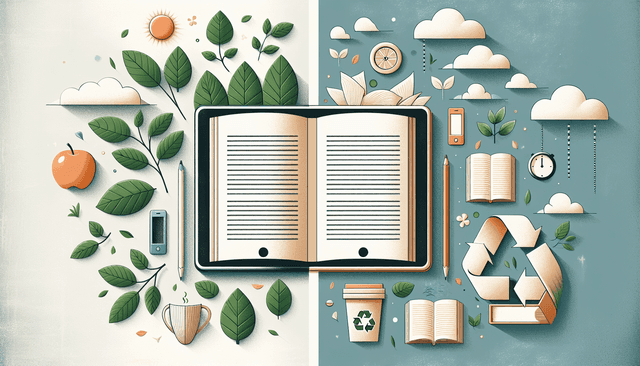Table of Contents
It’s no secret that publishing comes with a hefty environmental price tag. Many of us love our books, magazines, and online articles, but it’s hard to ignore the impact they can have on our planet. From deforestation to carbon emissions, the publishing industry isn’t exactly a poster child for environmental stewardship.
But don’t worry! If you stick around, we’ll unpack some fascinating insights and solutions on how to enjoy your reading habits while reducing your environmental footprint. You’ll discover practical options that make a difference, whether you’re a bookworm or a casual reader.
In this exploration, we’ll dive into the types of environmental damage caused by publishing, compare digital and print formats, and discuss the role of consumers in fostering sustainable practices. Plus, we’ll look at some inspiring case studies of eco-friendly initiatives in the publishing world. Let’s turn the page together towards greener reading!
Key Takeaways
- The publishing industry significantly impacts the environment through deforestation, pollution, and waste.
- Digital books reduce paper waste but have their own energy consumption costs.
- Choosing eco-friendly publishers and using recycled materials can lessen your reading footprint.
- Consumers can help by supporting sustainable practices, recycling old books, and using libraries.
- The future of publishing is leaning toward greener initiatives with innovations in materials and processes.
- Highlight examples of publishers committed to sustainability to guide smarter purchasing choices.

The Environmental Impact of Publishing
The publishing industry has a significant environmental footprint, affecting everything from deforestation to energy consumption.
Did you know that producing a single book can require up to 7.5 pounds of paper, leading to large-scale logging?
The carbon emissions associated with printing, distributing, and disposing of books contribute to climate change.
In a digital age, we must consider how our reading habits impact the planet, as eBooks and audiobooks also come at an ecological cost.
Types of Environmental Damage from Publishing
There are several key areas where publishing impacts the environment, including deforestation, pollution, and waste generation.
Deforestation results from the demand for paper, which can destroy habitats and reduce biodiversity.
Production processes often involve chemicals that pollute air and water, harming local ecosystems.
Moreover, discarded books can add to landfill waste, with millions of copies thrown away every year.
Resources Used in the Publishing Process
The publishing process consumes numerous resources, primarily paper, ink, and energy.
Paper production requires water and electricity, emphasizing the need for sustainable sourcing like recycled paper.
Ink, which is often petrochemical-based, can also pose environmental risks during production and disposal.
Understanding these resource demands helps us appreciate alternative publishing methods, such as self-publishing, which can reduce waste.

Digital vs. Print Publishing: Environmental Considerations
The choice between digital and print publishing can significantly influence the environment.
On one hand, eBooks eliminate the need for paper and printing, which reduces deforestation and waste.
However, eReaders and digital devices consume energy and require materials that have their own environmental impact.
If you prefer digital, try to use devices with longer lifespans or consider reading on your phone, which most of us already have.
For print lovers, seek out publishers that utilize recycled paper and eco-friendly inks, minimizing the carbon footprint.
Ultimately, being mindful of your choices can help strike a balance between enjoying reading and caring for the planet.
Carbon Footprint of Publishing
The carbon footprint of the publishing industry is larger than you might think, primarily due to production and distribution.
Everything from paper manufacturing to transportation contributes to greenhouse gas emissions.
For instance, printed books require energy-intensive processes—from pulp and paper production to shipping.
On the digital side, data centers powering the internet also consume lots of electricity, which often comes from fossil fuels.
To offset your reading carbon footprint, look into using carbon offset programs or support publishers committed to sustainability.
It’s all about being conscious of the impacts of your reading habits, whether digital or print.
Sustainable Practices in the Publishing Industry
The publishing industry is slowly adopting sustainable practices to reduce its environmental impact.
Many publishers now prioritize using recycled materials and eco-friendly inks in their printing processes.
Some are also adopting digital-first strategies, minimizing the need for physical copies unless absolutely necessary.
Additionally, initiatives like print-on-demand not only cut down on waste but also reduce overproduction.
As a consumer, you can support these changes by purchasing books from eco-conscious publishers or opting for self-published works using sustainable methods.
By choosing wisely, we all play a part in creating a greener publishing landscape.
The Role of Consumers in Reducing Environmental Impact
Consumers hold significant power in the publishing industry and can lead the charge for eco-friendly practices.
By consciously choosing to buy from publishers that prioritize sustainability, every purchase sends a message.
Additionally, donating or recycling old books keeps them out of landfills and breathes new life into stories.
Using local libraries can also be a fantastic way to enjoy books without the environmental cost of new copies.
Finally, advocating for sustainable practices in your own communities can lead to a broader impact, encouraging the industry to change.
The Future of Eco-Friendly Publishing
The future of publishing is set to embrace sustainability more than ever before, driven by consumer awareness.
Innovations such as biodegradable materials and energy-efficient printing processes are on the rise.
As digital formats evolve, we may also see advancements that reduce the energy consumption of eBook devices.
Publishers are increasingly likely to invest in sustainable practices in response to market demand.
Embracing eco-friendly methods doesn’t just benefit the environment—it’s becoming essential for brand loyalty and market competitiveness.
As a reader, you can stay informed and support enterprises that aim for a greener future.
Case Studies of Green Publishing Initiatives
Several publishers are leading the way with green initiatives designed to reduce environmental footprints.
For instance, a publication like Green Books focuses on eco-friendly practices, sourcing paper from sustainable forests.
Another example is Penguin Random House, which is committed to reducing its carbon emissions and using more sustainable materials in its production processes.
These companies show that publishing can go green without sacrificing quality or creativity.
When you buy books from these initiatives, you’re not just reading—you’re contributing to the solution.
Explore different publishers and their practices to find those that resonate with your values.
FAQs
The main environmental issues from publishing include deforestation, water pollution from ink and chemicals, energy consumption during production, and waste generation from printed materials that aren’t reused or recycled.
Digital publishing generally has a lower environmental impact since it reduces paper use and energy consumption associated with printing. However, it still consumes significant electricity and resources for data storage and transmission.
Sustainable practices include using recycled paper, environmentally friendly inks, digital solutions to minimize waste, and implementing energy-efficient production processes. Publishers can also plant trees to offset their carbon footprint.
Consumers can help by choosing digital formats over print, supporting publishers with sustainable practices, recycling printed materials, and being mindful of unnecessary purchases. Educating others about eco-friendly options also aids in reducing impact.



